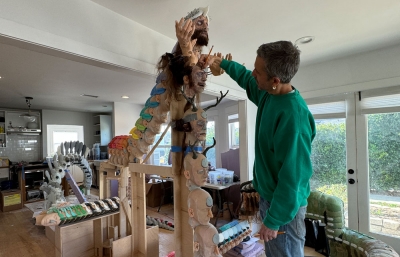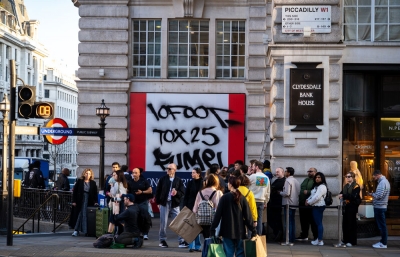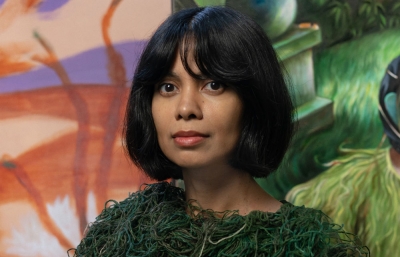I feel like a lot of your paintings are the reality of trying to make sense of the American Dream, but more in the sense of “Hey, wait, when does the dream start?"
I also took in a lot of the adult animation boom of the 1990s, like “The Simpsons,” “King of the Hill,” and “Beavis and Butt-Head” which are really satires of the American suburban dream. A parody of America, really. A lot of characters in my paintings are from that vantage point, a parody of American life and a spoof on reality. But I do it through the lens of biography. These characters are real in a sense. They are critiquing the whole idea of what it's like to "Make it." My work is really about the trials and tribulations of late American capitalism. And I create these underbelly-esque characters and scenarios that critique the whole idea of “work until you live the dream.”
What does Gas Station Dinner mean to you?
There was a long list of names, but I feel like that one stuck out to me and my friends. They know me best, and maybe they thought it was authentic to me. In a way, a gas station dinner is the fuel for the show. It’s that idea, and the reality, of just going to the liquor store around the block from the studio and multiple 7-Elevens and not spending a lot of money on food or not a lot of care in meal preparation, and how that becomes your de facto fuel for creativity. On the move, not thinking about much else. It’s about that camaraderie with your friends when you are making a show like this because we're doing it in the studio and we're surviving off of $8 meals every day.
It's also a play on the American context of dinner being so important and culturally significant. The idea that you sit with your family for dinner, or you go on dinner dates, or you have a dinner party with friends. That's a very intimate thing where people get to know each other, and it's something that I’m playing with in the title. A gas station dinner is something that is a little less romantic or a little less glorified. To have that as the name is a little bit of an ode to my friends and an ode to those times when you're down bad.
When did graffiti become part of your life? And did it make sense to you right away that this was a good way for you to find yourself?
I think just being a kid in a big city, you're prone to seeing and doing graffiti. I think it's just inevitable that you would come up with a tag. To me, it was just a part of the whole “dysfunction as hobby” part of childhood. You do kind of reckless stuff to keep from being bored—more about being “bad” than it was about going further into the world—that was graffiti. It was mostly to take up time, and it wasn’t about some sort of path I was on.
You were the youngest of five kids. Did you grow up in a creative family?
We come from an artistic family, maybe not in the traditional sense, but I think my dad used art and drawing, not so much as expression but as a tool of draftsmanship and getting ideas across. I think my mom is the one with the good eye. My mom is the one who kind of has the taste in my family. She can curate anything and make it look good—a kitchen, the whole house. And she has this amazing skill where she knows good movies from bad movies. That might seem funny to say, but I think that is a skill, and not a lot of people can do that. So it was all sort of there for me, in its own way.
I have three sisters and an older brother, and he grew up during the early 90’s comic book boom. That influenced me just by looking at the drawings, like The Crow and Spawn. And my sisters did a really good job of showing me early gateways into art. LA had a lot of places that weren't necessarily high-end. They weren’t necessarily on the radar of interest for my sisters or me, but there were a lot of places that could offer art to a wide crowd that were this gateway drug to art. If you wanted to go deeper, those places were good places. I’m thinking of Meltdown Comics, or Golden Apple Comics, these are the places that made me want to do art.














